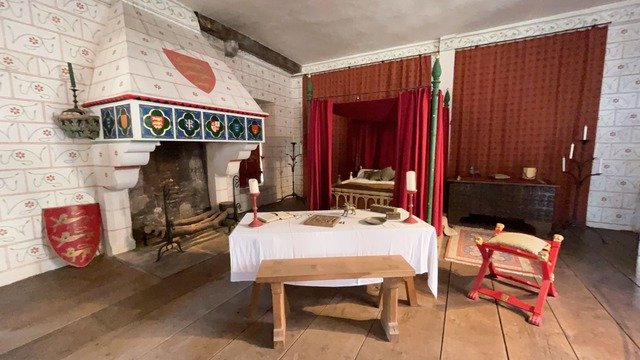
Audio Guide Script
St Thomas’s Tower is one of the most historically significant structures within the Tower of London complex. Built between 1275 and 1279 during the reign of King Edward I, this tower offers a fascinating glimpse into medieval royal life and architecture.
As you approach, notice how the tower once stood directly on the River Thames before the construction of the wharf. The large archway beneath the tower, now known as Traitors’ Gate, originally served as a water entrance for the king’s royal barge.
Step inside, and you’ll find yourself in what was once a grand medieval hall. This space, now left unrestored, was where the king would dine and entertain guests. Look closely, and you can still see remnants of the original 13th-century fireplace, a garderobe (medieval toilet), and a beautifully vaulted turret.
Moving further into the tower, we come to the reconstructed royal bedchamber. This room has been carefully recreated to represent how it might have appeared in Edward I’s time. The furnishings you see are replicas based on 13th-century designs. Notice the vibrant colors and intricate patterns – these are faithful representations of medieval tastes.
The king’s bed is positioned near the fireplace for warmth, but also allows a view of the small chapel that once stood over the water. The wall paintings you see are inspired by descriptions of floral designs in the chamber of Edward’s mother.
An interesting fact about medieval royal furniture: it was designed to be easily dismantled and transported, as the court frequently moved between different residences.
St Thomas’s Tower is not just a testament to medieval architecture, but also to the power and prestige of the English monarchy. It served as a royal residence within the fortress, offering both security and luxury to its royal inhabitants.
As we conclude our visit to St Thomas’s Tower, take a moment to imagine the many historical figures who once walked these floors, from King Edward I himself to the countless nobles and dignitaries who would have been entertained here. This tower stands as a remarkable link to England’s medieval past.
About King Edward I

King Edward I, also known as Edward Longshanks and ‘the Hammer of the Scots.’ Born in 1239, Edward ascended the throne in 1272 and ruled until his death in 1307. His reign was marked by significant military campaigns, architectural achievements, and legal reforms that reshaped England’s influence and identity.
Edward I was a determined and strategic leader, known for his ambitious conquests. His campaigns in Wales led to the construction of impressive castles, fortresses meant to secure his control over newly conquered territories. Many of these castles, such as those in Caernarfon and Conwy, still stand today, showcasing Edward’s understanding of military architecture.
His approach to the Tower of London was no different. Edward made extensive modifications here in the 1270s, strengthening its fortifications and expanding it to support both military and royal functions. Under Edward, the Tower became not just a fortress but a residence and a symbol of royal authority. He added structures such as the outer walls and the water-gate, later known as the Traitors’ Gate, which provided access by boat from the Thames.
Edward was also a powerful legislator and helped shape the legal framework of England. He implemented laws that protected individual rights and formalized procedures, leaving a lasting impact on English governance. Known for his strong sense of justice, he worked to centralize power and uphold the law — sometimes with an iron hand.
One of Edward’s most ambitious campaigns was against Scotland. Determined to bring Scotland under English rule, he led several invasions, capturing castles and even seizing the Stone of Scone, an ancient symbol of Scottish kingship. Though he was unable to fully subdue Scotland, his relentless efforts earned him the ominous title ‘Hammer of the Scots.’
Edward’s legacy is complex. He was a brilliant strategist, a relentless ruler, and a figure both respected and feared. His architectural, legal, and military contributions laid a foundation that would influence England long after his reign. As you walk through the Tower, remember that much of what you see was shaped by Edward’s hand, from the imposing walls to the dark history that unfolded within them.
Let’s continue to Wakefield Tower. From here on, it’s one way, so you won’t get lost.
